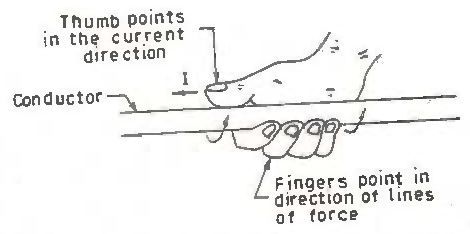Electrical Engineering ⇒ Topic : Right Hand Rule
|
|
| Sachin
| |
This law is particularly suitable to find the direction of the induced e.m.f. and hence current when the conductor moves at right angles to a stationary magnetic field. It may be stated as under Stretch out the forefinger, middle finger and thumb of your right hand so that they are at right angles to one another If the forefinger points in the direction of magnetic field, thumb in the direction of motion of the conductor, then the middle finger will point in the direction of induced current. FIGURE (A) Consider a conductor AB moving upwards at right angles to a uniform magnetic field as shown in Figure (a). Applying Fleming's right-hand rule, it is clear that the direction of induced current is from B to A. If the motion of the conductor is downward, keeping the direction of magnetic field unchanged, then the direction of induced current will be from A to B. | |
|
| |
| Gaurav
| |
Right hand rule (or right hand screw rule) The direction of the magnetic field can be found by using right hand rule or the right hand screw rule. The right hand rule states as follows: "Grasp the wire in the right hand, with the thumb pointing in the direction of the current. The fingers will curl around the wire in the direction of the magnetic field". Fig.(a) illustrates this rule. Fig.(a) Right hand rule (or right hand screw rule). The right hand screw rule can be explained as follows: As a wood screw is turned clockwise it moves (or progresses) into the wood. The horizontal direction of the screw is analogous to the direction of current in a conductor. The circular motion of the screw shows the direction of the magnetic flux around the conductor. | |
|
| |
!! OOPS Login [Click here] is required for more results / answer

